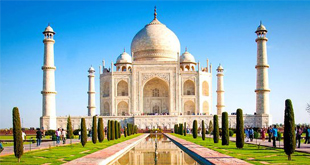Agra is the city of the Taj Mahal, in the north Indian state of Uttar Pradesh, some 200 km from Delhi.
Agra has three UNESCO World Heritage sites, the Taj Mahal and the Agra Fort in the city and Fatehpur Sikri nearby. There are also many other buildings and tombs from Agra’s days of glory as the capital of the Mughal Empire.
The city has little else to recommend it. Pollution, especially smog and litter, is rampant and travellers are pestered by swarms of touts and hawkers at every monument, mosque, temple or palace. That said, the sites are some of the wonders of the world and no trip to India is complete without at least one visit to the Taj.
Due to the very high number of tourists, Agra is a breeding ground for touts and people looking to separate you from your money. People from all over the world visit Agra to see India’s most famous building – the Taj Mahal.
Places of Interests
Taj Mahal Taj Mahal Sheer poetry in marble. Majesty and magnificence, unrivalled. The Taj Mahal, the one and only one of its kind across the world. The monumental labour of love of a great ruler for his beloved queen. The ultimate realisation of Emperor Shah Jehan’s dream. From 1631 A.D., it took 22 years in the making. An estimated 20,000 people worked to complete the enchanting mausoleum, on the banks of the Yamuna. For a breathtaking beautiful view of the Taj Mahal, see it by moonlight.
The Agra Fort – The great Mughal Emperor Akbar commissioned the construction of the Agra Fort in 1565, A.D. although additions were made till the time of his grandson Shah Jehan. The forbidding exteriors of this fort hide an inner paradise. There are a number of exquisite buildings like Moti Masjid – a white marble mosque akin to a perfect pearl; Diwan-I- Am, Diwan-I-Khaas, Musamman Burj – where Shah Jehan died in 1666 A.D. Jahangir’s Palace; Khaas Mahal and Shish Mahal.
Chini Ka Rauza – This was constructed by Afzal Khan – a high official in the court of Shah Jehan. Decorated by glazed tiles on the façade, the structure clearly depicts the Persian influence in architecture.
Ram Bagh – One of the earliest Mughal gardens, it was laid out by Emperor Babar – the founder of the Mughal dynasty. It is said that Babar was temporarily buried here before being permanently interred at Kabul in Afghanistan.
Sikandra – The mausoleum of Emperor Akbar represents his philosophy and secular outlook, combining the best of Hindu and Muslim architectures in a superlative fusion. Completed in 1613 A.D., it is a well-preserved monument.
Itmad-ud-daulah – This exquisite marble tomb was got constructed by Emperor Jehangir’s queen, Nurjahan, for her father Mirza Ghiyas Beg during 1622 – 1628 A.D. The craftsmanship at Itmad-ud-Daulah foreshadows that of the Taj Mahal. It was here that ‘Pietra Dura’ the inlay work on marble – so characteristic of the Taj – was first used.
Mariyam’s Tomb – This unique tomb in red sandstone was built in 1611 A.D. in memory of Emperor Akbar’s Goan-Christian wife – Mariyam. The tomb has some exceptional carvings.
Jama Masjid – This building, with a rectangular open forecourt was constructed in 1648 AD by Shah Jehan’s daughter, Jehanara Begum in memory of the famous Sheikh Salim Chishti and his grandson Islam Khan. Of particular importance is its wonderful assimilation of Iranian architecture.
Radha Saomi Samadhi, Dayalbagh – The headquarters of the Radha Saomi sect. On the sprawling lawns here, is a beautiful marble temple under construction for almost 100 years now. Open : 8.am to 7 pm. (Entry free upto 15 years age and free for all on Fridays). These monuments are open to visitors everyday throughout the year)
